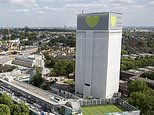Grenfell insulation is on more than 70 schools
Grenfell insulation is on more than 70 schools: Flammable material was used on dozens of buildings despite it being BANNED on tower blocks after tragedy
- More than 70 schools are using the flammable insulation used on Grenfell Tower
- The material is banned from being used on residential buildings over 18 metres
- However, there is currently no ban in place for other buildings shorter than that
Insulation used on Grenfell Tower has been found on more than 70 schools despite being banned from high-rise apartment blocks after the 2017 tragedy.
Flammable plastic foam insulation was banned from being used on any residential buildings that are over 18 metres in height in December 2018.
However, a shock new study from insulation manufacturer Rockwool, has discovered more than 70 schools are still using the insulation.
The Joseph Leckie academy in Walsall, in the West Midlands, even uses the same Kingspan insulation used on Grenfell Tower.
Some others are using the high-pressure laminate panels used on the Cube student housing block in Bolton that caught fire in 2019.
The research also discovered that about 25 recently built hospitals, care homes and sheltered housing complexes are likely to have used combustible insulation – although it warned that the figure was an ‘underestimate’.


Plastic foam insulation, which burns, was banned from being used on any residential buildings after the Grenfell Tower tragedy
Since the Grenfell tragedy in 2017, housing blocks more than 18 metres in height are banned from using combustible materials.
However, since then, several fires have devastated shorter buildings leading to calls for the ban to be extended to schools.
Last Thursday, the Department for Education unveiled new fire safety proposals for schools buildings that continue to allow combustible cladding on structures below 18 metres in height.
The release of the Rockwool report has triggered fury and concern for children’s safety.
Geoff Barton, the general secretary of the Association of School and College Leaders, told the Guardian: ‘Action rather than discussion is needed now to remove and replace high-risk combustible materials and ensure the safety of young people and education staff.’
Dr Mary Bousted, the joint general secretary of the National Education Union, said: ‘It is clearly very unwise to choose to use insulation material that makes a school more likely to suffer a fire. Not only does it risk lives, but [there is] also disruption to education – not to mention the cost to the taxpayer in putting things right following a major fire.’
Insurer Zurich also revealed that 47 primary and secondary school buildings have been destroyed by fire in England in the last five years.
A spokesperson for the Ministry of Housing, Communities and Local Government (MHCLG) said: ‘We have already banned the use of all combustible materials on all high-rise flats and hospitals and student accommodation over 18 metres.


The Joseph Leckie academy in Walsall, in the West Midlands, even uses the same Kingspan insulation used on Grenfell Tower
‘On lower-rise buildings, all materials must pass tough safety checks before they can be used on a building and our building safety bill will ensure even more stringent oversight of products that are used on homes in future.’
The Department for Education has been contacted for comment.
Previously it was revealed that the boss of a firm that sold insulation used at Grenfell Tower told staff to let concerns about their product ‘gather dust’.
Industry certifying body the BBA first raised concerns with Kingspan’s Kooltherm K15 product in 2008 – nine years before a fire at the West London apartment block killed 72 people.
The concerns were raised two months after the product was first issued and the BBA offered to make several changes free of charge – according to emails shown when Kingspan employee Andrew Pack gave evidence to a public inquiry on Monday.
It is alleged that Mr Pack’s then-boss, Philip Heath, later forwarded the email with instructions to ‘let the file gather dust’.
The inquiry previously heard about Kingspan using outdated test material to suggest that K15 was safe for use in high-rise buildings above 18m tall.
![]()


